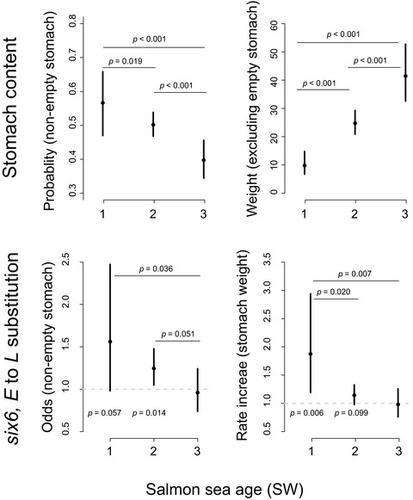当前位置:
X-MOL 学术
›
J. Anim. Ecol.
›
论文详情
Our official English website, www.x-mol.net, welcomes your feedback! (Note: you will need to create a separate account there.)
Life history genomic regions explain differences in Atlantic salmon marine diet specialization
Journal of Animal Ecology ( IF 4.8 ) Pub Date : 2020-09-28 , DOI: 10.1111/1365-2656.13324 Tutku Aykanat 1 , Martin Rasmussen 2 , Mikhail Ozerov 3, 4 , Eero Niemelä 3, 5 , Lars Paulin 6 , Juha‐Pekka Vähä 7 , Kjetil Hindar 8 , Vidar Wennevik 9 , Torstein Pedersen 2 , Martin‐A. Svenning 10 , Craig R. Primmer 1, 6
Journal of Animal Ecology ( IF 4.8 ) Pub Date : 2020-09-28 , DOI: 10.1111/1365-2656.13324 Tutku Aykanat 1 , Martin Rasmussen 2 , Mikhail Ozerov 3, 4 , Eero Niemelä 3, 5 , Lars Paulin 6 , Juha‐Pekka Vähä 7 , Kjetil Hindar 8 , Vidar Wennevik 9 , Torstein Pedersen 2 , Martin‐A. Svenning 10 , Craig R. Primmer 1, 6
Affiliation

|
Animals employ various foraging strategies along their ontogeny to acquire energy, and with varying degree of efficiencies, to support growth, maturation and subsequent reproduction events. Individuals that can efficiently acquire energy early are more likely to mature at an earlier age, as a result of faster energy gain which can fuel maturation and reproduction. We aimed to test the hypothesis that heritable resource acquisition variation that covaries with efficiency along the ontogeny would influence maturation timing of individuals. To test this hypothesis, we utilized Atlantic salmon as a model which exhibits a simple, hence trackable, genetic control of maturation age. We then monitored the variation in diet acquisition (quantified as stomach fullness and composition) of individuals with different ages, and linked it with genomic regions (haploblocks) that were previously identified to be associated with age-at-maturity. Consistent with the hypothesis, we demonstrated that one of the life-history genomic regions tested (six6) was indeed associated with age-dependent differences in stomach fullness. Prey composition was marginally linked to six6, and suggestively (but non-significantly) to vgll3 genomic regions. We further showed Atlantic salmon switched to the so-called 'feast and famine' strategy along the ontogeny, where older age groups exhibited heavier stomach content, but that came at the expense of running on empty more often. These results suggest genetic variation underlying resource utilization may explain the genetic basis of age structure in Atlantic salmon. Given that ontogenetic diet has a genetic component and the strong spatial diversity associated with these genomic regions, we predict populations with diverse maturation age will have diverse evolutionary responses to future changes in marine food web structures.
中文翻译:

生活史基因组区域解释了大西洋鲑鱼海洋饮食专业化的差异
动物在其个体发育过程中采用各种觅食策略来获取能量,并以不同程度的效率来支持生长、成熟和随后的繁殖事件。能够在早期有效获取能量的个体更有可能在较早的年龄成熟,因为能量获得更快,可以促进成熟和繁殖。我们旨在检验这样一个假设,即与个体发育效率共变的可遗传资源获取变异会影响个体的成熟时间。为了验证这一假设,我们使用大西洋鲑鱼作为模型,该模型展示了成熟年龄的简单、可追踪的遗传控制。然后,我们监测了不同年龄个体的饮食获取(量化为胃饱胀度和成分)的变化,并将其与先前被确定与成熟年龄相关的基因组区域(单倍块)联系起来。与假设一致,我们证明测试的生活史基因组区域之一(66)确实与年龄相关的胃饱胀差异有关。猎物组成与 66 略有关联,并暗示(但不显着)与 vgll3 基因组区域相关。我们进一步表明,大西洋鲑鱼在个体发育过程中转向了所谓的“盛宴和饥荒”策略,其中年龄较大的群体胃内容物更重,但代价是更频繁地空腹奔跑。这些结果表明资源利用的遗传变异可以解释大西洋鲑鱼年龄结构的遗传基础。
更新日期:2020-09-28
中文翻译:

生活史基因组区域解释了大西洋鲑鱼海洋饮食专业化的差异
动物在其个体发育过程中采用各种觅食策略来获取能量,并以不同程度的效率来支持生长、成熟和随后的繁殖事件。能够在早期有效获取能量的个体更有可能在较早的年龄成熟,因为能量获得更快,可以促进成熟和繁殖。我们旨在检验这样一个假设,即与个体发育效率共变的可遗传资源获取变异会影响个体的成熟时间。为了验证这一假设,我们使用大西洋鲑鱼作为模型,该模型展示了成熟年龄的简单、可追踪的遗传控制。然后,我们监测了不同年龄个体的饮食获取(量化为胃饱胀度和成分)的变化,并将其与先前被确定与成熟年龄相关的基因组区域(单倍块)联系起来。与假设一致,我们证明测试的生活史基因组区域之一(66)确实与年龄相关的胃饱胀差异有关。猎物组成与 66 略有关联,并暗示(但不显着)与 vgll3 基因组区域相关。我们进一步表明,大西洋鲑鱼在个体发育过程中转向了所谓的“盛宴和饥荒”策略,其中年龄较大的群体胃内容物更重,但代价是更频繁地空腹奔跑。这些结果表明资源利用的遗传变异可以解释大西洋鲑鱼年龄结构的遗传基础。


























 京公网安备 11010802027423号
京公网安备 11010802027423号